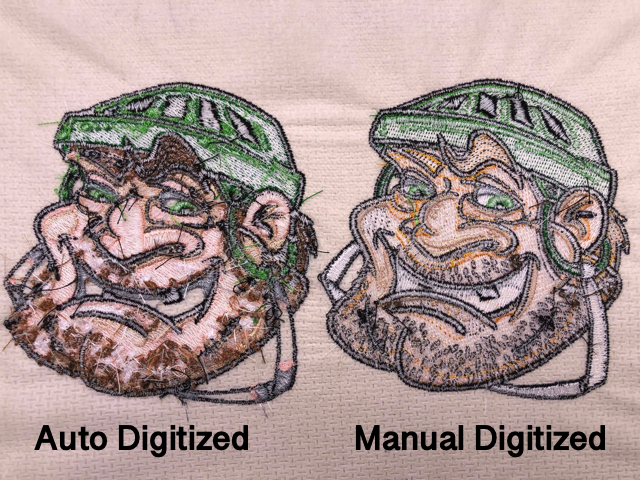Understanding the Embroidery Digitizing Process: Your Ultimate Overview
Embroidery digitizing is a meticulous craft that calls for precision and expertise to equate elaborate designs right into digital styles for machine embroidery. As artisans start this trip to master the needlework digitizing procedure, a thorough understanding of the essentials sets the foundation for quality. Beyond the fundamental expertise exists a realm of sophisticated software, specialized devices, and nuanced methods waiting to be checked out. By delving into the nuances of digitizing, one can open a world of imaginative possibilities and boost their needlework jobs to new elevations.

Comprehending Needlework Digitizing Fundamentals
Embroidery digitizing fundamentals form the structure upon which intricate designs are translated right into machine-readable layouts for exact sewing. This preliminary step in the embroidery digitizing process is crucial for making sure that the final stitched product is a devoted depiction of the initial design. Comprehending needlework digitizing fundamentals involves understanding vital ideas such as stitch types, stitch direction, thickness, underlay, and draw compensation.
Sew kinds play an essential duty in establishing the aesthetic and textural outcome of the embroidered style. By selecting the ideal stitch type, whether it be satin, fill, or running stitch, digitizers can accomplish the wanted impact and boost the overall top quality of the needlework. In addition, stitch instructions influences the flow and measurement of the style, while density figures out the spacing and insurance coverage of the stitches.
Moreover, rug stitching gives security to the layout by securing the fabric and preventing distortion throughout the needlework procedure. Pull compensation is another crucial factor to consider to counteract the all-natural tendency of textile to contract when stitched. Understanding these needlework digitizing basics is essential for producing professional-quality embroidered items.
Picking the Right Digitizing Software Program
Choosing the appropriate digitizing software is an essential decision that significantly impacts the efficiency and quality of the needlework digitizing process. Digitizing for Embroidery. When picking the best digitizing software, it is important to think about variables such as the complexity of designs you intend to produce, the user-friendliness of the software program, the degree of client assistance used, and the compatibility with your embroidery machine
There are various digitizing software program choices available in the marketplace, ranging from basic programs for beginners to advanced software program for expert digitizers. Some popular selections consist of Wilcom EmbroideryStudio, Hatch Needlework Software Program, and PulseID. These software offer a vast array of tools and functions to assist you develop detailed styles with convenience.
Prior to deciding, it is recommended to explore the various software options through cost-free trials or demonstrations to identify which one best suits your needs. Furthermore, reading evaluations and seeking suggestions from seasoned digitizers can give valuable understandings into the staminas and weaknesses of each software (Digitizing for Embroidery). By thoroughly examining your needs and contrasting the attributes of different digitizing software application, you can make an educated selection that boosts your embroidery digitizing process
Digitizing Devices and Techniques

Optimizing Layout Setup for Needlework
Mastering the ins and outs of layout settings is fundamental in achieving optimum results in the embroidery digitizing process, building upon the structure laid by comprehending digitizing tools and strategies. When enhancing design setups for needlework, it is crucial to try these out think about factors such as stitch type, density, underlay, pull payment, and registration. Registration settings line up various aspects of the style accurately, maintaining total layout stability.

Troubleshooting Common Digitizing Issues
When coming across typical digitizing concerns during the needlework process, it is important to recognize the source and carry out reliable services promptly. One usual trouble is stitch thickness issues, where stitches may be also thick, triggering the textile to tighten, or too thin, leading to spaces in the design. Adjusting the stitch density settings in the digitizing software application can aid solve this problem.
Another frequent challenge is string breaks throughout the embroidery process. This can take place as a result of numerous reasons such as inaccurate stress setups, dull needles, or using low-quality string. Guaranteeing appropriate maintenance of the embroidery equipment, including regular needle modifications and tension changes, can lessen the event of string breaks.
Furthermore, style enrollment mistakes can result in misaligned aspects within the embroidery design. Checking the layout positioning in the digitizing software and making required adjustments before stitching can assist in avoiding this problem. By attending to these typical digitizing problems promptly and successfully, you can make sure a smoother embroidery procedure and top notch finished products.
Conclusion
To conclude, mastering the needlework digitizing procedure requires a strong understanding of the basics, the appropriate option of software, and knowledge of tools and techniques. Enhancing layout setups and repairing common digitizing issues are essential steps in ensuring premium embroidery results. By complying with these actions carefully, one can attain precision and effectiveness in the digitizing procedure.